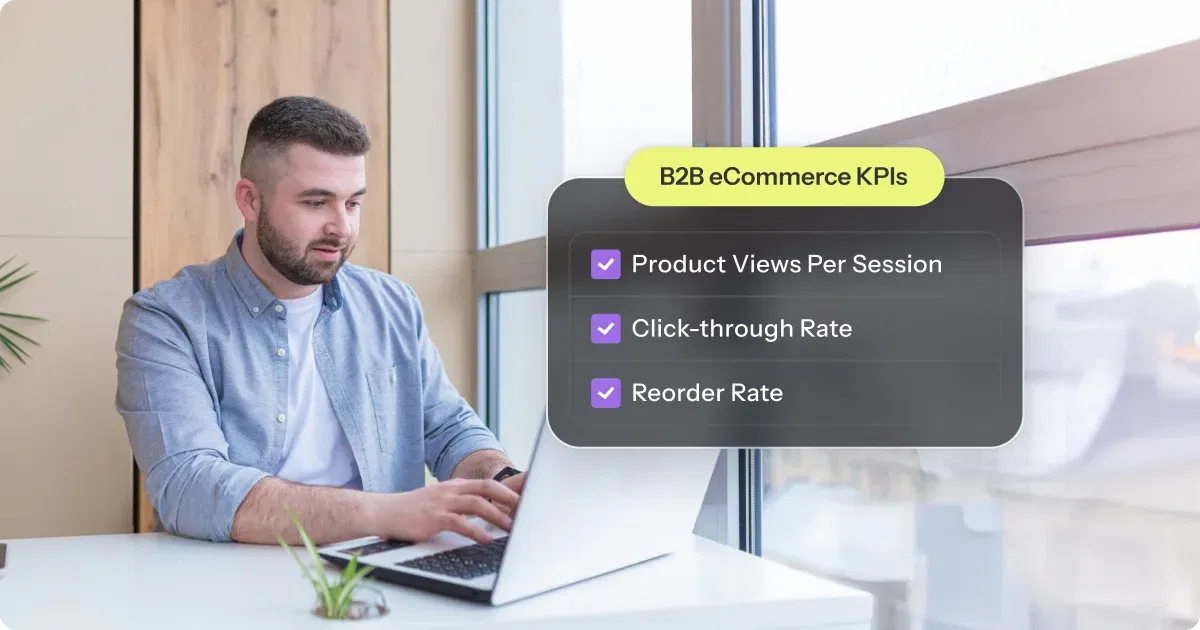- Blog
- eCommerce
- Agentic Experience
- 9 min read
Your E-store Requires a Detailed Customer Experience Audit!
Published
5 August 2025Updated
2 September 2025

core insights box
- Skipping regular CX audits is one of the fastest ways to lose potential customers, as unseen friction adds quickly.
- Common CX issues like bounce rates and poor engagement can be resolved by following a structured customer experience checklist.
- Regular CX audits drive better personalization, improve loyalty, and reduce drop-offs throughout the journey.
- Experro enables seamless CX optimization with AI-driven search, smart product discovery, and real-time personalization.
Are you ignoring the real reason behind dropping conversions?
Sometimes, the issue isn’t the product, it’s the experience. If your online store is seeing unexpected drops in engagement or a surge in bounce rates, it might be time to step back and take a closer look.
That’s where a customer experience audit checklist comes in. It uncovers blind spots across the eCommerce customer journey audit, helping you fine-tune every touchpoint.
Let’s break down the signs, checklist, benefits, and pitfalls, so your brand can stay one step ahead.
What Are the Signs You Need a Customer Experience Audit?
Spotting issues early can save you from long-term CX damage. If any of these red flags sound familiar, a digital experience audit is no longer optional.
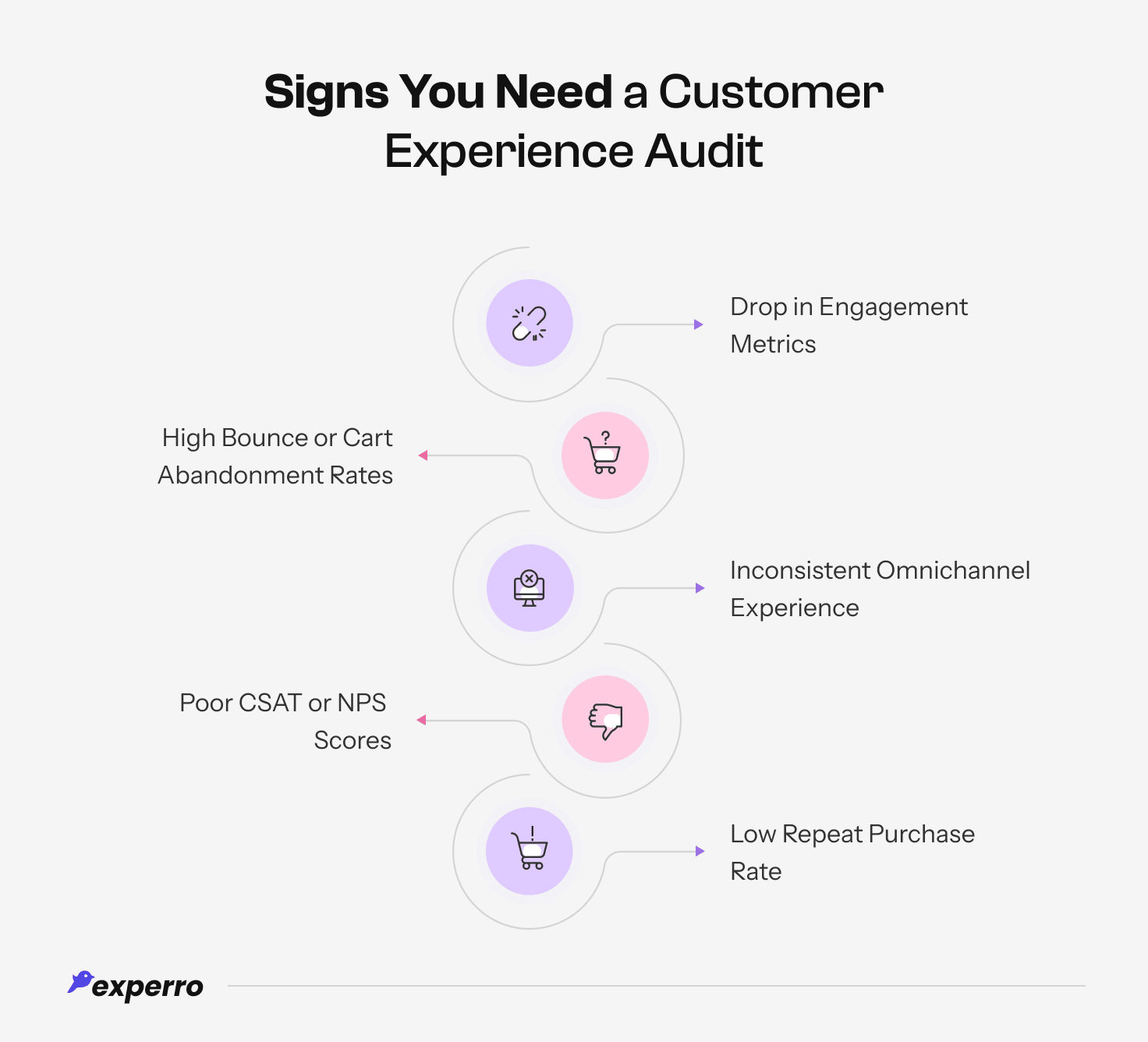
1. Drop in Engagement Metrics
A steady decline in email open rates, low click-throughs, and short session durations are strong indicators of CX gaps.
Digital experience analytics highlight that your content or interface isn’t resonating with your audience. It could be your product page customer experience needs attention, or your eCommerce homepage audit is due.
A gen AI CX checklist can even uncover missing personalization elements that might drive engagement back up.
2. High Bounce or Cart Abandonment Rates
If users are landing on your site and leaving without engaging with your products, or worse, abandoning their carts, it’s time to investigate.
This may indicate poor eCommerce touchpoint optimization, weak CTAs, or disjointed dynamic product landing pages.
These signs often hint that friction exists between customer intent and site performance, making a homepage experience audit and eCommerce category page CX analysis essential.
3. Inconsistent Omnichannel Experience
Your customer might see one message on Instagram and another in an email. That inconsistency dilutes trust and confuses buyers.
Whether it’s mobile, desktop, or in-app, a mobile customer experience audit ensures every channel contributes to a seamless omnichannel eCommerce experience.
A good CX audit for B2C eCommerce aligns voice, branding, and offers across all platforms.
4. Poor Customer Satisfaction (CSAT) or Net Promoter Score (NPS) Scores
Customer satisfaction scores are a mirror of your experience delivery. If they’re low, it’s not just support, it’s the full journey that needs reviewing.
A customer experience audit checklist helps pinpoint exactly where the breakdown is happening, from slow pages to irrelevant product suggestions.
Regular audits improve trust and sentiment over time.
5. Low Repeat Purchase Rate
If customers aren’t returning, there’s a post-purchase disconnect. This might be due to a broken eCommerce CX checklist, unhelpful follow-ups, or a lack of meaningful personalization.
Loyalty grows when the brand remembers and adapts to the customer, a capability that a generative AI customer experience solution can greatly enhance.
Audit Smarter with the eCommerce Customer Experience Checklist
A successful eCommerce customer experience checklist isn’t about fixing what’s broken, it’s about proactively optimizing what’s working.
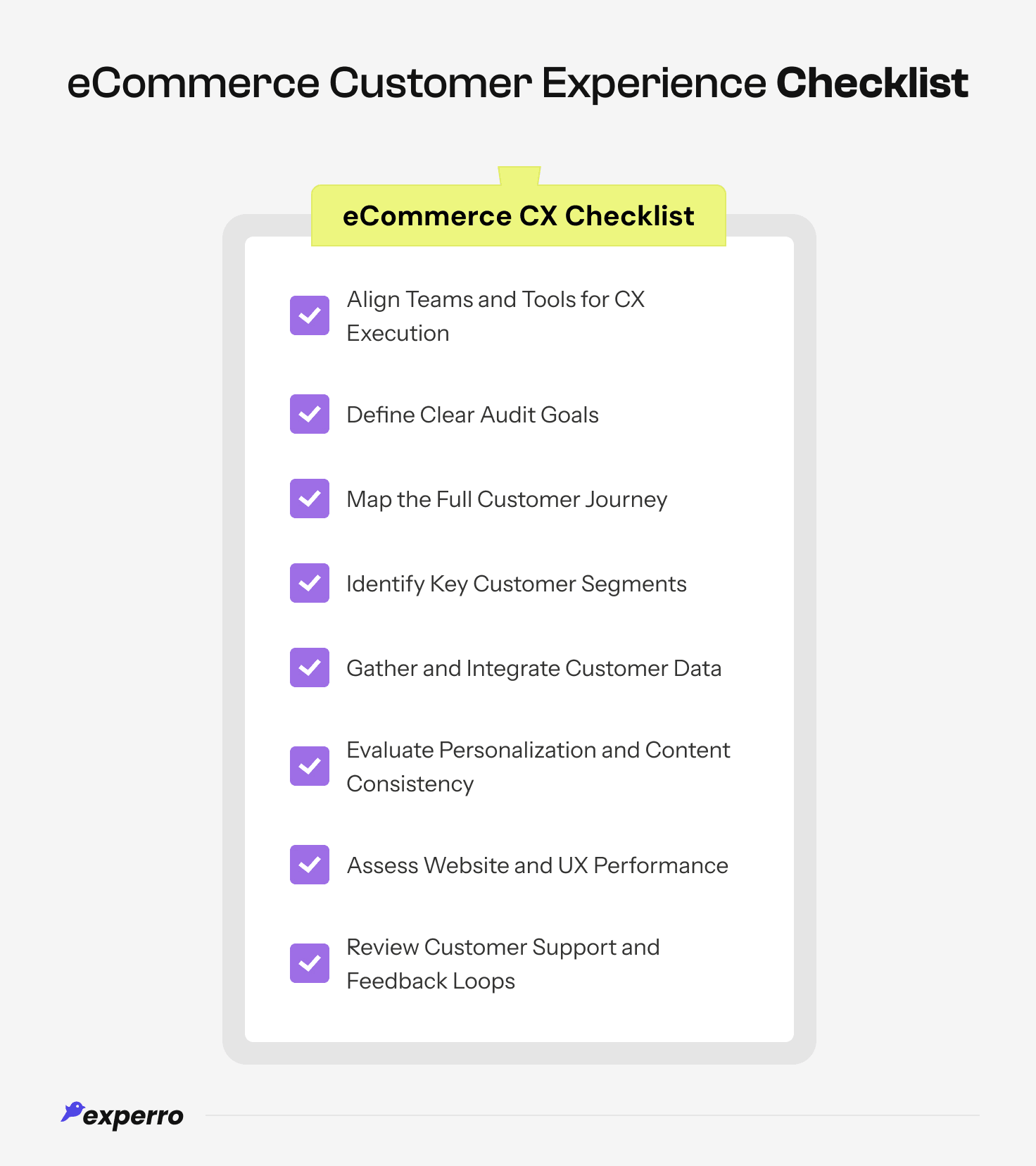
Here’s what to include for a robust audit:
1. Define Clear Audit Goals ✅
Know what you’re trying to achieve before diving in. Whether it’s improving checkout flow or boosting eCommerce personalization, every action should tie back to a measurable outcome.
This forms the base of your eCommerce CX checklist, ensuring you're not just guessing what to fix.
2. Map the Full Customer Journey ✅
Create a visual map from first touch to post-purchase in order to capture friction points. A proper eCommerce customer journey orchestration helps understand user behavior and intent.
Mapping also helps isolate drop-off zones and prioritize which ones to fix first.
3. Identify Key Customer Segments ✅
Your CX strategy can’t be one-size-fits-all. Segment your target audience by behavior, purchase history, and intent.
This improves your audit's accuracy and supports efforts like AI-powered dynamic product experiences, enabling targeted UX enhancements.
Segmented content and campaigns deliver up to 33% higher customer lifetime value and as high as 760% growth in revenue when done well.
4. Gather and Integrate Customer Data ✅
Pull data from all sources like CRM, eCommerce analytics, reviews, and heatmaps. Unified data is essential for actionable insights.
It allows AI agents for eCommerce CX to function better and provide real-time, customer-aware recommendations.
5. Evaluate Personalization and Content Consistency ✅
Verify that your messaging, content personalization, and product recommendations are genuinely tailored to each user.
Is the user getting the right offer at the right time? Because the lack of consistency can hurt trust.
This is where Gen AI CX checklist tools come in handy to evaluate and adapt on the fly.
6. Assess Website and UX Performance ✅
Is your site intuitive? Are the CTAs placed correctly? Are load times optimized?
A product page customer experience or eCommerce homepage audit helps ensure you're not losing customers due to overlooked UX details.
7. Review Customer Support and Feedback Loops ✅
Your CX doesn’t end with purchase. Ensure you have timely support options, including chatbots and survey loops.
This strengthens loyalty and provides data for the next round of the digital experience audit.
8. Align Teams and Tools for CX Execution ✅
Ensure your marketing, product, and support teams are aligned on CX objectives. Use collaborative platforms and customer experience KPIs to track progress.
This cross-team synergy makes your customer experience audit checklist more effective and sustainable.
Experro helps you avoid these mistakes with a quick Search & Discovery Experience Checklist!

What Are the Benefits of Regular Customer Experience Audits?
A CX audit isn’t a one-time fix, it’s an ongoing strategy for competitive advantage.

Here’s what regular auditing can unlock for your business:
1. Better Personalization
Frequent audits help refine personalization by showing what’s working and what’s missing. You can better leverage AI-powered dynamic product experiences and hyper-personalization to tailor offerings at scale.
Over time, this makes each user feel like the brand knows them. It also ensures that personalization stays relevant as customer personas evolve.
2. Improved Retention & Customer Lifetime Value
When customers enjoy seamless, engaging journeys, they come back. Regular audits help maintain that experience, which in turn improves retention and increases customer lifetime value.
Post-holiday customer retention is especially challenging, as shoppers often disengage after seasonal spikes. For B2C brands, a structured CX audit for B2C eCommerce store can drive exponential retention results. Higher retention also reduces acquisition costs, improving overall profitability.
3. Reduced Friction in the Buyer Journey
From clunky mobile menus to hidden CTAs, friction kills conversions. Audits uncover and eliminate these hurdles.
Combined with tools like smart collections or AI Browse, your eCommerce site becomes easier to navigate and buy from. This leads to faster checkouts, fewer abandoned carts, and a more intuitive experience.
4. Enhanced Brand Perception
Consistent and smooth interactions strengthen brand trust. Customers remember how you made them feel.
This is where generative AI customer experience solutions help by dynamically adapting tone, visuals, and offers. Stronger perception also increases word-of-mouth referrals and social proof.
5. Data-Driven Decision Making
An audit turns gut feelings into facts. By using insights from your eCommerce CX checklist, you make decisions backed by real-time customer behavior, not just assumptions.
It leads to smarter campaigns and fewer wasted resources. Customer experience audit also fosters continuous improvement across your CX strategy.
Together, these benefits make your customer journey smoother and your brand stronger. Regular CX audits help you stay in tune with customer needs and keep your business moving forward.
Deliver seamless, personalized shopping experiences powered by Experro!
What Are the Common Mistakes to Avoid in Customer Experience Audits?
While CX audits are essential, doing them wrong can do more harm than good.
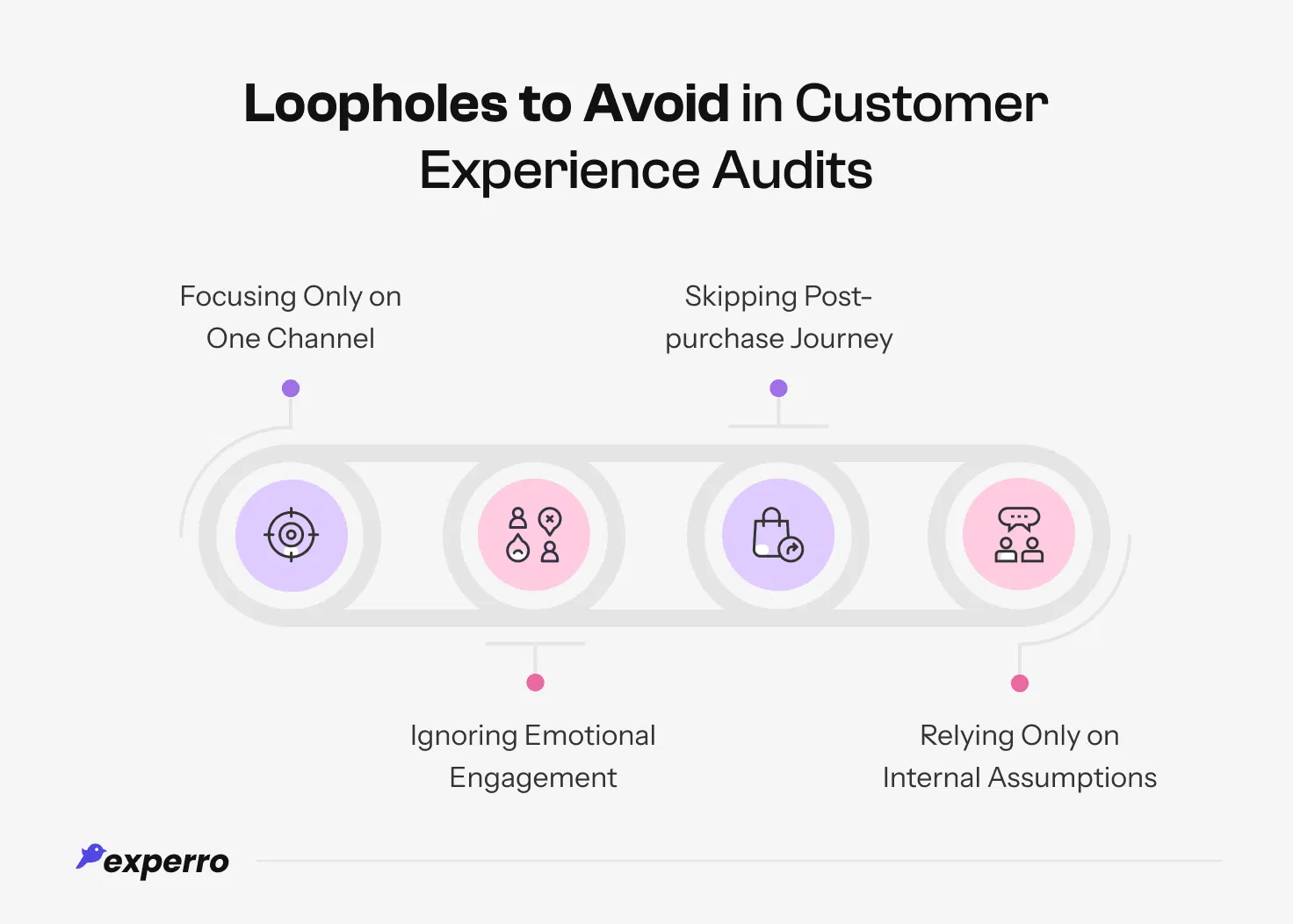
Here are the pitfalls to avoid:
1. Focusing Only on One Channel
Looking at just your website while ignoring mobile, email, or social media creates blind spots.
A mobile customer experience audit is just as vital as your desktop review. Today’s customers jump between platforms, and your CX must meet them everywhere.
2. Ignoring Emotional Engagement
Metrics alone don’t show how the customer feels. Emotional resonance is a huge part of customer loyalty.
Your digital experience audit and eCommerce analytics should include sentiment analysis, reviews, and feedback to ensure you're connecting on a human level.
3. Skipping Post-Purchase Journey
Many audits end at checkout, but the real experience continues afterward. Missing out on the post-purchase phase means losing valuable insights and loyalty opportunities.
This stage is where AI agents for eCommerce CX can elevate customer support and retention.
4. Relying Only on Internal Assumptions
If your team is auditing based on what they believe customers want, it's a clear path to misalignment. Use real user data, feedback, and behavior heatmaps.
The eCommerce customer experience checklist must be built on external truths, not internal bias.
Where Experro Fits in Your CX Optimization Journey?
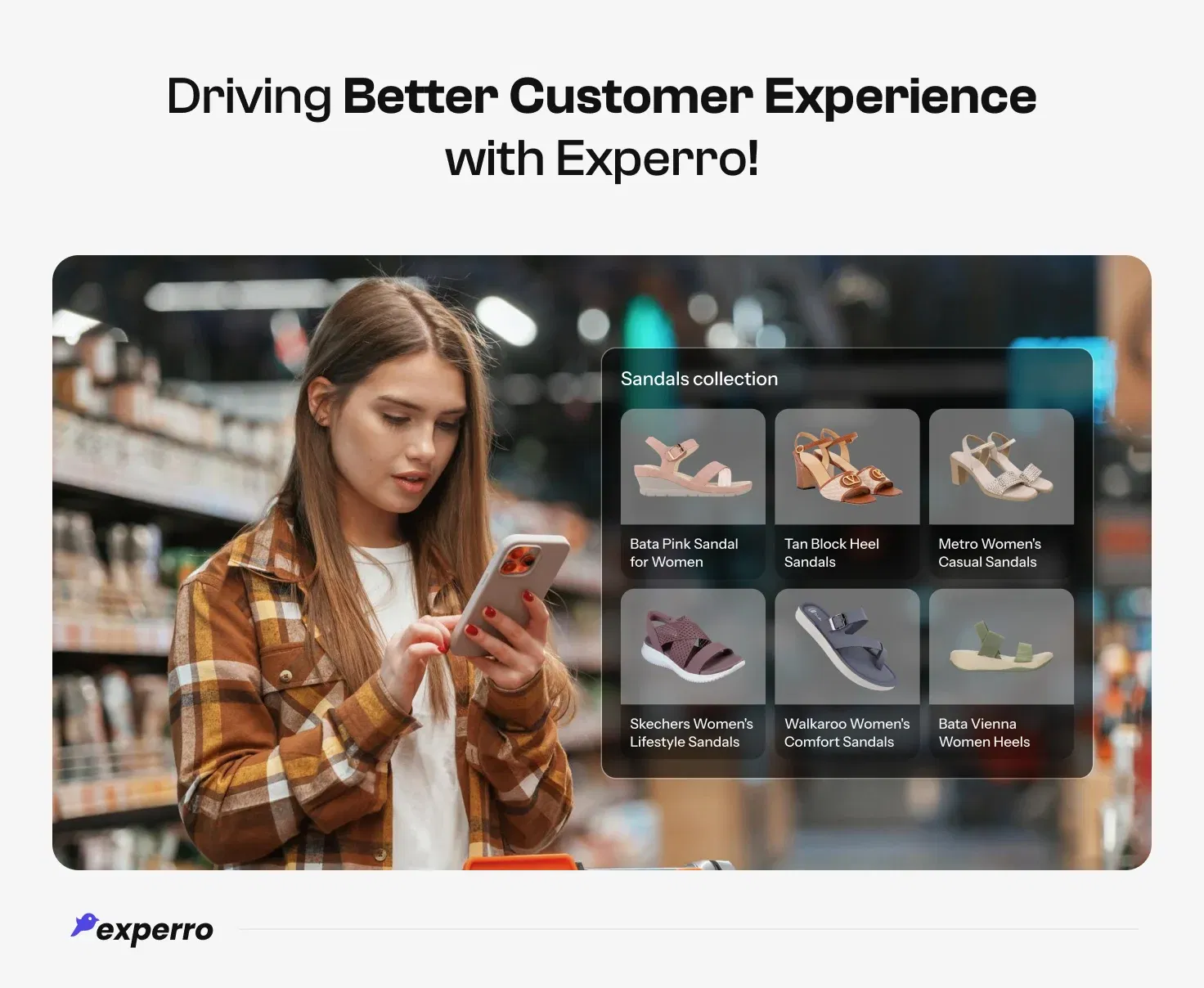
Experro offers a future-ready solution to help brands deliver top-notch experiences across every touchpoint.
Whether you’re conducting an eCommerce homepage audit, improving your eCommerce category page cx, or planning a full customer experience audit checklist, Experro empowers you with tools to make it easy and effective.
- Gen AI-Powered Search helps customers find products faster with natural language queries.
- AI-powered Recommendations offer tailored suggestions based on browsing and buying patterns.
- AI Browse helps users explore dynamically without predefined filters, perfect for enhancing discovery.
- Smart Collections group products automatically for better merchandising and smoother UX.
All these features work in tandem to boost your generative AI customer experience strategy, and help you stay miles ahead in your industry.
Deliver better shopping outcomes by enhancing CX with Experro!
Conclusion
A great customer experience doesn't happen by chance, it’s the result of intentional design, regular auditing, and data-backed improvements.
Whether you're a startup or an established brand, adopting a structured eCommerce customer experience checklist can make all the difference in driving loyalty and revenue.
Connect on a call with our experts for a free CX consultation tailored to your brand.
FAQs
What is the purpose of a CX audit?
A customer experience (CX) audit helps uncover inefficiencies, friction points, and inconsistencies across the customer journey mapping.
It provides actionable insights to improve personalization, usability, emotional engagement, and overall satisfaction. The goal is to ensure every customer interaction aligns with your brand promise and enhances loyalty.
How often should a business conduct a CX audit?
An eCommerce business must conduct a CX audit at least once every six months. However, for fast-growing eCommerce brands or those frequently launching new campaigns or features, quarterly audits are ideal.
Regular audits help businesses stay aligned with evolving customer expectations and rapidly adapt to market changes.
What’s the difference between a CX audit and a UX audit?
A UX audit focuses specifically on usability, user interface design, and the overall functionality of a digital platform.
In contrast, a CX audit takes a broader approach, evaluating the entire customer journey from discovery to support while also considering emotional engagement, service consistency, and brand perception. UX is one part of the larger CX picture.
Can small businesses benefit from a CX audit?
Absolutely. Even with fewer resources, small businesses can benefit significantly from a CX audit. It helps them identify simple yet impactful improvements that enhance the customer journey, boost retention, and increase repeat purchases.
A focused audit allows smaller teams to prioritize changes that deliver strong ROI without requiring large budgets.
What areas of the customer journey does a CX audit cover?
A CX audit evaluates key touchpoints across the customer lifecycle to identify gaps and improve performance.
A typical eCommerce customer journey audit covers:
- Homepage experience audit
- Product page customer experience
- Dynamic product landing pages
- eCommerce category page CX
- Mobile customer experience audit
- Checkout page and cart experience
- Post-purchase emails and communication
- Customer support interactions
- Loyalty and re-engagement efforts
- Omnichannel consistency
This helps ensure complete eCommerce touchpoint optimization from start to finish.
Pallavi Dadhich
Content Writer @ ExperroPallavi is an ambitious author recognized for her expertise in crafting compelling content across various domains. Beyond her professional pursuits, Pallavi is deeply passionate about continuous learning, often immersing herself in the latest industry trends. When not weaving words, she dedicates her time to mastering graphic design.
What's Inside
- What Are the Signs You Need a Customer Experience Audit?
- Audit Smarter with the eCommerce Customer Experience Checklist
- What Are the Benefits of Regular Customer Experience Audits?
- What Are the Common Mistakes to Avoid in Customer Experience Audits?
- Where Experro Fits in Your CX Optimization Journey?
- Conclusion
Subscribe to Our Newsletters
Get the latest insights delivered straight to your inbox.


